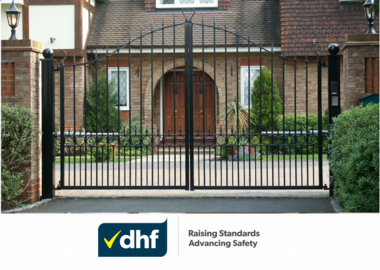
To assist its members and the wider industry, Tamworth-based trade association, the Door & Hardware Federation (DHF), has provided advice on powered gate hinge safety, in particular, pertaining to gate hinge failure, and has created a members only publication on this subject entitled, ‘Powered Gate Hinge Safety’ - https://bit.ly/32G4d0T
As Nick Perkins, Senior Training & Compliance Officer at DHF explains, when gate hinges suffer a failure, heavy gates can fall over which can prove fatal to those in the vicinity. One particular example was in 2013, when a heavy steel gate fell and killed 67-year-old, Myra Goldman, when its bottom hinge failed. The coroner investigating her death issued a regulation 28 report to HSE and BSI, ‘to prevent future death’, and demanding that standards be improved. In his discoveries, the coroner had noted that a common practice used to prevent gates being lifted off their hinges had led to critical vulnerability, and then to failure.
“At the time of the incident, it was common to fit gates with two hinges, the lower one with the hinge pin facing up, and the top one with the hinge pin facing down. In this design, the lower hinge bears the vast majority of the weight, wear and stress caused in normal use; subsequently, it is the most likely hinge to suffer damage or a structural failure,” explains Nick. “If and when it fails, there is nothing remaining to support the gate resulting in it falling.”
In 2016, the British standard for gates and fences, BS 1722, was revised to prevent this practice leading to further fatalities.
“The case of Myra Goldman had a knock-on effect for powered gates,” continues Nick. “Many powered gates originate from manual gates provided by fencing contractors that are later automated by others, with the effect that several have unsuitable and potentially unsafe hinge arrangements. In fact, the standard for powered gates, EN 12453, has since its first publication in 2000, required the structure of the system to conform to EN 12604, which has always required that failure of any one suspension element (e.g. a hinge) should not allow a gate to fall. EN 12604 was later revised in 2017 to allow a degree of flexibility of design with the effect that it also provided a safe and compliant means to upgrade existing sub-standard systems.”
The standard currently allows a limited amount of falling over from the fully upright position, and therefore, there are now at least three means of providing a safe and compliant hinge design; firstly, two hinges and a safety lanyard (limited fall), three hinges (no movement or fall), and two reinforced hinges, any one of which will keep the gate from falling (providing some movement, but no fall).
9th September 2024
Join dhf
Enjoy the full benefits of dhf membership
Apply today